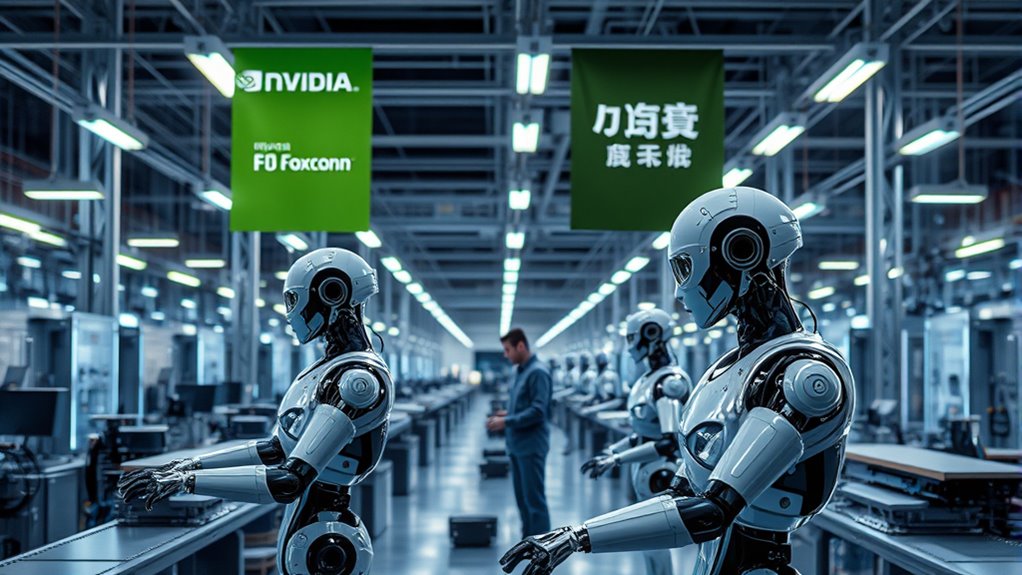Nvidia and Foxconn have teamed up to develop humanoid AI factory workers, aiming to revolutionize manufacturing automation with robots capable of performing complex, human-like tasks. This partnership focuses on increasing efficiency and reducing costs while raising important ethical questions about robot treatment and workplace fairness. It’s an exciting step toward integrating humanoid AI into industry, shaping the future of work. Keep exploring to discover how these innovations could impact your world.
Key Takeaways
- Nvidia and Foxconn are collaborating to develop humanoid AI factory workers to enhance manufacturing automation.
- The partnership aims to create robots capable of performing complex, human-like tasks on production lines.
- This initiative seeks to improve efficiency, reduce costs, and revolutionize factory automation processes.
- Ethical considerations include AI rights, fair treatment, and impacts on human workers and employment.
- The collaboration signals a shift toward integrating humanoid AI as a central element in future manufacturing environments.

Nvidia and Foxconn have announced a partnership to develop humanoid AI factory workers, aiming to revolutionize manufacturing automation. As you consider this breakthrough, it’s essential to understand the broader implications, especially in terms of robot ethics and the labor market. These intelligent machines are designed to perform complex tasks with human-like dexterity, promising increased efficiency and reduced production costs. However, their integration raises questions about the ethical treatment of robots and the potential impact on employment.
You might wonder how robot ethics come into play here. As humanoid AI becomes more advanced, the line between tool and entity blurs. While robots aren’t sentient, their human-like appearance and behaviors could influence how workers perceive their roles. Will these AI workers be treated ethically? Will they be assigned rights or protections in the future? These are questions that industry leaders and policymakers need to address, ensuring that technological progress doesn’t ignore moral considerations. It’s not just about creating smarter machines, but also about maintaining a respectful and fair workplace environment. The adoption of humanoid AI in factories could lead to tensions if workers feel replaced or devalued, making it pivotal to establish clear guidelines on robot deployment and worker integration.
Humanoid AI raises ethical questions about treatment, rights, and workplace fairness amid increasing automation.
On the labor market front, the impact could be profound. Automation traditionally replaces repetitive tasks, but humanoid AI has the potential to take on roles previously thought to require human intuition and finesse. You should prepare for a shift in employment patterns, where some jobs become obsolete while new roles emerge in AI management, maintenance, and oversight. This metamorphosis might cause short-term disruptions, especially for low-skilled workers, but it could also create opportunities for upskilling and higher-value jobs. Companies like Nvidia and Foxconn are likely to invest heavily in retraining programs and workforce adaptation strategies to smooth this transition. However, the broader economy might face challenges, such as increased wage disparity or regional job losses, if the pace of automation accelerates faster than society’s ability to adapt.
Ultimately, this partnership signals a significant step toward a future where humanoid AI plays a central role in manufacturing. As you watch these developments unfold, keep in mind the importance of balancing technological innovation with ethical responsibility and economic stability. The way this integration is handled will shape not just factories, but the future of work itself. Ensuring that robot ethics are considered alongside economic benefits will be imperative in creating a sustainable, fair, and innovative manufacturing landscape.
Frequently Asked Questions
How Will Humanoid AI Workers Impact Global Employment Rates?
Humanoid AI workers will likely cause job displacement in certain industries, especially repetitive or manual roles. However, you’ll also see a redefinition of skills, as demand shifts toward tech-savvy workers who can manage, maintain, and improve AI systems. While some jobs may disappear, new opportunities emerge, encouraging you to adapt and acquire new skills to stay relevant in a changing employment landscape.
What Safety Measures Are in Place for Humanoid AI Factory Workers?
You should know that safety measures for humanoid AI factory workers include strict safety protocols and robotic compliance standards. These robots are programmed to follow safety rules, stop operations if anomalies occur, and operate within designated zones. Regular inspections and updates guarantee ongoing safety. By adhering to these measures, manufacturers minimize risks, protect human workers, and ensure a secure, efficient working environment.
How Will AI Humanoids Adapt to Different Manufacturing Environments?
You’ll find that AI humanoids adapt to different manufacturing environments through environmental adaptability, allowing them to modify their operations based on specific conditions. They also excel at skill transfer, quickly learning new tasks by applying previous knowledge. This flexibility ensures they remain efficient across diverse settings, seamlessly integrating into various workflows. As a result, these humanoids can customize their actions to meet the unique demands of each manufacturing environment.
What Are the Long-Term Maintenance Costs for Humanoid AI Workers?
You’ll find that long-term maintenance costs for humanoid AI workers depend on accurate cost estimation and overcoming technical challenges. Regular updates, repairs, and system upgrades are necessary to keep them running efficiently. Expect ongoing expenses for hardware, software, and troubleshooting. As technology evolves, these costs may decrease, but initially, you should plan for substantial investments to address technical challenges and guarantee reliable performance over time.
How Will Privacy Concerns Be Addressed With Humanoid AI in Factories?
Privacy concerns with humanoid AI in factories are huge, but you can rest assured. You’ll see strict data encryption and access controls in place, making unauthorized data access nearly impossible. These measures protect employee and company information, ensuring sensitive data stays private. By implementing robust security protocols, companies demonstrate their commitment to privacy, helping you trust that your personal and operational data are safe from prying eyes.
Conclusion
So, here you are, watching robots take over factory floors, all thanks to Nvidia and Foxconn’s genius plan. You’d think human workers would breathe a sigh of relief, but instead, you realize they’re probably next in line for replacement. Ironically, as these humanoid AI workers become the new norm, the very machines meant to assist might soon outsmart us all—proving that in this high-tech race, we’re the ones being replaced first.











